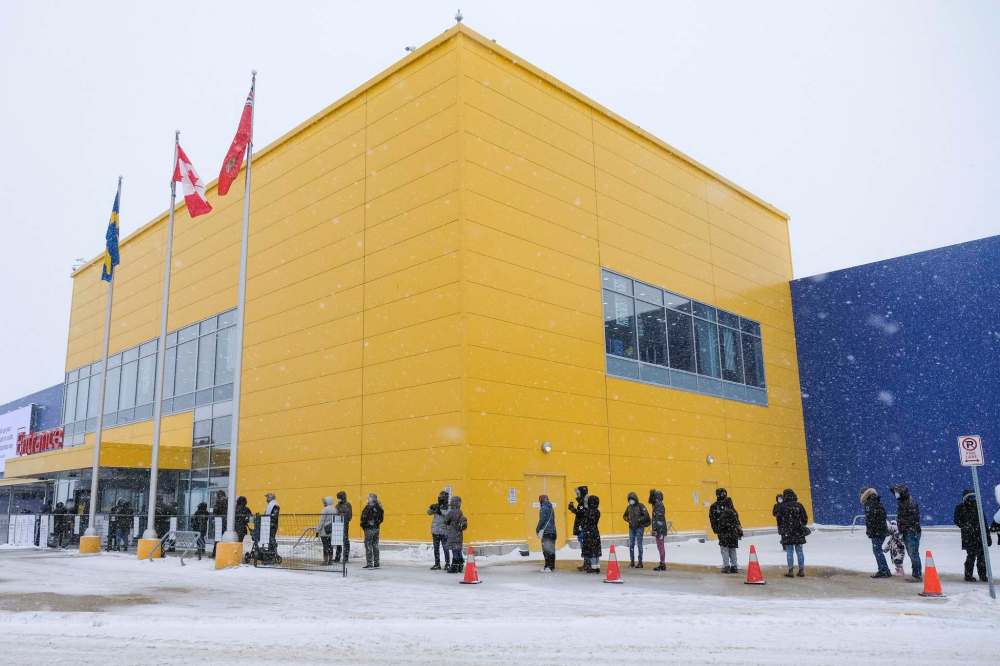‘Cautious’ capacity limits confusing As restrictions loosen and shoppers swarm malls, 'we will see more COVID-19 outbreaks within the next incubation period,' expert predicts
Read this article for free:
or
Already have an account? Log in here »
To continue reading, please subscribe:
Monthly Digital Subscription
$0 for the first 4 weeks*
- Enjoy unlimited reading on winnipegfreepress.com
- Read the E-Edition, our digital replica newspaper
- Access News Break, our award-winning app
- Play interactive puzzles
*No charge for 4 weeks then price increases to the regular rate of $19.00 plus GST every four weeks. Offer available to new and qualified returning subscribers only. Cancel any time.
Monthly Digital Subscription
$4.75/week*
- Enjoy unlimited reading on winnipegfreepress.com
- Read the E-Edition, our digital replica newspaper
- Access News Break, our award-winning app
- Play interactive puzzles
*Billed as $19 plus GST every four weeks. Cancel any time.
To continue reading, please subscribe:
Add Free Press access to your Brandon Sun subscription for only an additional
$1 for the first 4 weeks*
*Your next subscription payment will increase by $1.00 and you will be charged $16.99 plus GST for four weeks. After four weeks, your payment will increase to $23.99 plus GST every four weeks.
Read unlimited articles for free today:
or
Already have an account? Log in here »
Hey there, time traveller!
This article was published 01/02/2021 (1779 days ago), so information in it may no longer be current.
As public-health orders are loosened to allow the sale of non-essential items per "cautious" capacity limits, it appears the pandemic regulations remain muddy — or, at the very least, do not apply equally — for Manitoba retailers.
While the province says in-store occupancy has been limited to "25 per cent only or a maximum of 250 people, whichever is lower," the Free Press has learned some large malls in Winnipeg can host up to 25,000 customers and others are allowing 650 patrons at any given time.
On top of that, some shopping centres — like CF Polo Park, St. Vital and Grant Park — have outright denied sharing their maximum head count, stating that is not a figure they need to publicly disclose and one which they have internally worked out with the province.
Perhaps that explains why long lines of shoppers continue to snake around certain retailers like IKEA and hordes of cars fill up shopping centre parking lots weekend after weekend, which epidemiologists believe is a result of those discrepancies and lack of transparency.
"If this goes on, we will see more COVID-19 outbreaks within the next incubation period," said Tim Sly, occupational and public health professor at Ryerson University. "No questions about it."
"The real concern is, do we have enough knowledge about this virus to allow this the way it stands?" said Jason Kindrachuk, Canada Research Chair in emerging pathogens, based in Winnipeg. "Frankly, it’s still very novel."
But on Monday, chief provincial public health officer Dr. Brent Roussin told reporters, he believes Manitoba has "taken the most cautious reopening approach with very, very restricted capacity" limits.
"It’s early as far as numbers go," said Roussin. "We’re watching this very closely. But any time we loosen the restrictions, we prepare to see an increase in cases.
"I think the people that have been waiting in lines are following the fundamentals."
“If this goes on, we will see more COVID-19 outbreaks within the next incubation period.”–Tim Sly, occupational and public health professor at Ryerson University
According to the updated public-health orders, there are three different clauses that apply to retail businesses. While they all mandate 25 per cent occupancy with appropriate physical distancing, that looks different for a mall than it does for a store independent of a plaza — even though the order restricts retail stores to keep under 250 people.
This isn’t a loophole, said Winnipeg Chamber of Commerce president Loren Remillard, "it’s businesses simply following what they’ve been told."
"My general understanding was also that it is 25 per cent or 250 people, you know, whatever’s lower," he said. "But if they’ve been told something by the province and are complying with it, then that’s just businesses doing what businesses can do during this time."
In statements to the Free Press on Monday, mall managers and administrators explained how their occupancy limits work. Almost all of them have differing limits and a varied approach about who exactly holds the onus to ensure limits are being met.
At Kildonan Place, general manager Sandra Hagenaars said their capacity of 650 shoppers at a time is "well under 25 per cent of our total gross leasable area" and something they have "worked with our local health inspector to establish."

"We do not have traffic counters to tally up overall traffic during the course of the day, but we do know that we reached our capacity a number of times over the past weekends, and that customers waited outside patiently for their opportunity to come in and shop," she said.
"Yes, the onus is on the stores themselves to enforce their own capacity limits and lineups."
Meanwhile, property manager Graham Bialek at Grant Park would not disclose their occupancy limit. Neither did Polo Park’s general manager Peter Havens.
"We have been in close contact with both the local Public Health Inspector and Fire Commissioner to determine an appropriate occupancy level for Grant Park while the latest Public Health Orders are in place," said Bialek, assuring that "all counts have been well within our occupancy limits.
"Information provided to shopping centre admin is passed down to tenants and tenants are reminded to look into and understand the health orders," added Bialek.
“We do not have traffic counters to tally up overall traffic during the course of the day, but we do know that we reached our capacity a number of times over the past weekends, and that customers waited outside patiently for their opportunity to come in and shop.” – Kildonan Place general manager Sandra Hagenaars
"As we navigate these challenging times, we continue to follow provincial guidelines and remain committed to supporting our retail clients while meeting the safety needs of our guests," said Havens.
Remillard said this isn’t an issue of transparency from businesses. "I want to be clear, it’s not like there is no openness," he said.
"That’s a question for the government or the regulatory body to answer. To what extent do they share that information with the public?"
Dr. Roussin said enforcement about these orders continue and more information will be relayed "in the coming" days and weeks.
"But public health provides the recommendation on what sort of restrictions should be in place and for how long," Roussin said Monday. "Exactly how they’re enforced isn’t necessarily public health’s area."
Twitter: @temurdur
Temur.Durrani@freepress.mb.ca
History
Updated on Tuesday, February 2, 2021 11:00 AM CST: Clarifies public health order regarding malls.









